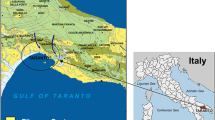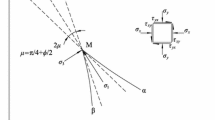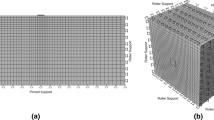Abstract
Numerical computations using the finite difference code FLAC (fast Lagrangian analysis of continua) are presented to evaluate the soil bearing capacity factors N′ c ,N′ q and N′ γ for circular smooth and rough footings. The influence of nonassociative flow rule on the ultimate bearing capacity of a circular footing is investigated. The footing rests on the surface of a homogeneous soil mass and a Mohr-Coulomb yield criterion have been assumed for the soil behavior. The values of ultimate bearing capacity factors N′ c ,N′ q and N′ γ are obtained for a wide range of values of the friction angle for five different values of the dilation angle. The values from the numerical simulation are found to decrease significantly with the increase of nonassociativity of the soil. The results are compared with those derived from existing classical solutions.
Similar content being viewed by others
References
Terzaghi K. Theoretical soil mechanics [M]. New York: John Wiley & Sons, 1943: 23–36.
Prandtl L. Uber die Harte plasticher Korper [M]. Nachrichten von der Koniglichen Gesellschaft der Wissenschaften, Gottingen: Mathematics and physics Klasse, 1920: 74–85.
Bolton M D, Lau K. Vertical bearing capacity factors for circular and strip footings on Mohr-Coulomb soil [J]. Canadian Geotechnical Journal, 1993, 30(4):1024–1033.
Shield R T. Stress and velocity fields in soil mechanics [J]. Journal of Mathematics and Physics, 1954b, 33(2): 144–156.
Chen W F. Limit analysis and soil plasticity [M]. Amsterdam: Elsevier, 1975: 79–93.
Drescher A, Detournay E. Limit load in translational failure mechanisms for associative and nonassociative materials [J]. Geotechnique, 1993, 43(3):443–456.
Griffiths D V. Computation of bearing capacity factors using finite elements [J]. Geotechnique, 1982, 32(3): 195–202.
Sloan S W, Randolph M F. Numerical prediction of collapse loads using finite elements method [J]. International Journal for Numerical and Analytical of Methods in Geomechanics, 1982, 6(1): 47–76.
Manoharan N, Drasgupta S P. Bearing capacity of surface footings by finite elements [J]. Computers and Structures, 1995, 54(4): 563–586.
Frydman S, Burd H J. Numerical studies of bearing capacity factor Nγ [J]. Journal of Geotechnical and Geoenvironmental Engineering, 1997, 123(1): 20–29.
Erickson H L, Drescher A. Bearing capacity of circular footings [J]. Journal of Geotechnical and Geoenvironmental Engineering, 2002, 128(1): 38–43.
Yin Jin-hua. Influence of nonassociativity on the bearing capacity of a strip footing [J]. Journal of Geotechnical and Geoenvironmental Engineering, 2001, 127(11): 985–989.
Borst R, Vermeer P A. Possibilities and limitations of finite elements for limit analysis [J]. Geotechnique, 1984, 34(2): 199–210.
Cox A D, Eason G, Hopkins H G. Axially symmetric plastic deformation in soils [C]//Philosophical Transactions of the Royal Society of London Series A. London: the Royal Society of London, 1961: 1–45.
Zhu F Y, Clark I, Phillips R. Scale effect of strip and circular footings resting on dense sand [J]. Journal of Geotechnical and Geoenvironmental Engineering, 2001, 127(7): 613–621.
Shield R T. On the plastic flow of metals under conditions of axial symmetry [C]//Proceedings of the Royal Society of London Series A. London: the Royal Society of London, 1955: 233–267.
Cox A D. Axially symmetry plastic deformation in soil. II. Indentation of ponderable soils [J]. International Journal of Mechanical, 1962, 4: 371–380.
Kumar J, Ghosh P. Determination of Nγ for rough circular footing using the method of characteristics [J]. Electronic Journal of Geotechnical Engineering, 2005, 1: 618–627.
Vesic A S. Analysis of ultimate loads of shallow foundations [J]. Journal of Soil Mechanics and Foundations, 1973, 99(1): 45–73.
Davis E H. Theories of plasticity and the failure of soil masses [M]. London: Butterworths, 1968: 341–380.
Michalowski R L, Shi L. Bearing capacity of footings over two-layer foundation soils [J]. Journal of Geotechnical and Geoenvironmental Engineering, 1995, 21(5): 421–428.
Michalowski R L. An estimate of the influence of soil weight on bearing capacity using limit analysis [J]. Soils and Footings. 1997, 37(4): 57–64.
Author information
Authors and Affiliations
Corresponding author
Additional information
Foundation item: the National Natural Science Foundation of China (No. 50679041), and the Mountaineering Program of Science and Technology Commission of Shanghai Municipality (No. 04dzl 2001)
Rights and permissions
About this article
Cite this article
Zhao, L., Wang, Jh. Influence of nonassociativity on the bearing capacity factors of a circular footing. J. Shanghai Jiaotong Univ. (Sci.) 14, 429–434 (2009). https://doi.org/10.1007/s12204-009-0429-0
Received:
Published:
Issue Date:
DOI: https://doi.org/10.1007/s12204-009-0429-0




